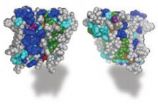(Press-News.org) Johns Hopkins scientists have decoded for the first time the "stability blueprint" of an enzyme that resides in a cell's membrane, mapping which parts of the enzyme are important for its shape and function. These studies, published in advance online on June 14 in Structure and on July 15 in Nature Chemical Biology, could eventually lead to the development of drugs to treat malaria and other parasitic diseases.
"[It's] the first time we really understand the architectural logic behind the structure of the enzyme," says Sinisa Urban, Ph.D., an associate professor of molecular biology and genetics at the Johns Hopkins University School of Medicine and an investigator at the Howard Hughes Medical Institute, who with his team has unlocked the mysteries of a special class of enzymes called rhomboid proteases.
Rhomboid proteases are present in many different organisms, and are a unique type of enzyme that resides in the cell's membrane where they cut proteins. Previously Urban and his colleagues demonstrated that the rhomboid enzyme is critical for Plasmodium falciparum, the parasite that causes malaria, to successfully invade red blood cells, a step that ultimately leads to infection. Urban says understanding the stability of rhomboid protease shape may impact the design of enzyme inhibitors – potential drugs. "These enzymes have no selective inhibitors," says Urban. "We really need to understand how [the enzyme] works – is it as stiff as a rock, or is it more gummy, like Jell-O?"
One challenge of studying rhomboid enzymes is that they are surrounded by membranes, making them more difficult to manipulate and work with. To address this, Urban's research team turned to a technique known as thermal light scattering, which heats enzyme samples to progressively higher temperatures while measuring the amount of light bouncing back off of the molecules. Enzymes that have broken from their normal shape will scatter light differently, and the temperature at which this occurs (in effect, the breaking point of the enzyme) indicates the inherent stability of the enzyme.
The researchers first precisely measured the stability of the rhomboid enzyme from E. coli bacteria. Surprisingly, says Urban, the rhomboid enzyme was more "Jell-O-like" than other membrane proteins with similar shapes. He guesses that this "jiggly shape" may help rhomboid proteases interact with other proteins that it cuts. To find which parts of the enzyme are most important for maintaining shape and which parts are more crucial for function, the researchers then made and tested 150 differently altered versions of the enzyme. They found four main regions important for maintaining shape and at least two regions important for function.
The researchers also took advantage of computer simulations to test their ideas about how the enzyme functions. Using a computer program model of the enzyme, they programmed in features of its natural membrane environment, which consists mostly of fats and is very limited in water. The computer program then simulated how this environment might influence the enzyme. Researchers found that the enzyme contains a special internal pocket for holding water molecules – a great advantage in its natural, water-limiting environment.
"We're very excited about our findings and are especially curious about the versions of the enzyme that lost function despite no obvious change in stability or shape," says Urban. Ultimately he hopes that a better understanding of rhomboid proteases will lead to new therapies for treating malaria and other parasitic diseases.
INFORMATION:
These studies were supported by the Howard Hughes Medical Institute, a National Institute of General Medical Sciences grant (GM079223), a National Institute of Allergy and Infectious Diseases grant (AI066025), the National Science Foundation (NSF) and the David and Lucile Packard Foundation.
Other researchers who participated in this study include Rosanna Baker, Yanzi Zhou, Syed Moin and Yingkai Zhang.
Related Stories:
Sinisa Urban on the tricky malaria parasite: http://www.hopkinsmedicine.org/institute_basic_biomedical_sciences/about_us/scientists/sinisa_urban.html
How Montezuma Gets His Revenge: http://www.hopkinsmedicine.org/news/media/releases/How_Montezuma_Gets_His_Revenge
For more information, visit:
http://www.mbg.jhmi.edu/Pages/people/profile.aspx?PID=193
http://www.mbg.jhmi.edu/Pages/index.aspx
Is it a rock, or is it Jell-O? Defining the architecture of rhomboid enzymes
2012-08-02
ELSE PRESS RELEASES FROM THIS DATE:
Mending a broken heart -- with a molecule that turns stem cells into heart cells
2012-08-02
LA JOLLA, Calif., August 2, 2012 – For years, scientists have been looking for a good source of heart cells that can be used to study cardiac function in the lab, or perhaps even to replace diseased or damaged tissue in heart disease patients. To do this, many are looking to stem cells. Researchers at Sanford-Burnham Medical Research Institute (Sanford-Burnham), the Human BioMolecular Research Institute, and ChemRegen, Inc. have been searching for molecules that convert stem cells to heart cells for about eight years—and now they've found one. Writing in the August 3 issue ...
Genetic copy-number variants and cancer risk
2012-08-02
Genetics clearly plays a role in cancer development and progression, but the reason that a certain mutation leads to one cancer and not another is less clear. Furthermore, no links have been found between any cancer and a type of genetic change called "copy-number variants," or CNVs. Now, a new study published by Cell Press in The American Journal of Human Genetics on August 2 identifies CNVs associated with testicular cancer risk, but not with the risk of breast or colon cancer.
Some cancers, including breast and colon cancer, are caused by mutations that are passed ...
It's in our genes: Why women outlive men
2012-08-02
Scientists are beginning to understand one of life's enduring mysteries - why women live, on average, longer than men.
Published today in Current Biology, research led by Monash University, describes how mutations to the DNA of the mitochondria can account for differences in the life expectancy of males and females. Mitochondria, which exist in almost all animal cells, are vital for life because they convert our food into the energy that powers the body.
Dr Damian Dowling and PhD student, Florencia Camus, both from the Monash School of Biological Sciences, worked with ...
'Unhealthy' changes in gut microbes benefit pregnant women
2012-08-02
The composition of microbes in the gut changes dramatically during pregnancy, according to a study published by Cell Press in the August 3rd issue of the journal Cell. Although these changes are associated with metabolic disease under most circumstances, they could be beneficial in pregnant women.
"This is the first in-depth characterization of the gut microbiota associated with pregnancy," says senior study author Ruth Ley of Cornell University. "The findings suggest that our bodies have coevolved with the microbiota and may actually be using them as a tool—to help alter ...
Scripps Florida scientists identify a critical tumor suppressor for cancer
2012-08-02
JUPITER, FL – August 2, 2012 – Scientists from the Florida campus of The Scripps Research Institute have identified a protein that impairs the development and maintenance of lymphoma (cancer of the lymph nodes), but is repressed during the initial stages of the disease, allowing for rapid tumor growth.
While the study, published in the August 3, 2012 edition of the journal Cell, largely focuses on the role of this new tumor suppressor in lymphoma induced by Myc oncoproteins (the cancer-promoting products of Myc oncogenes), the authors show this circuit is apparently operational ...
Study finds mechanism that turns white fat into energy-burning brown fat
2012-08-02
New York, NY (August 2, 2012) — Columbia University Medical Center (CUMC) researchers have identified a mechanism that can give energy-storing white fat some of the beneficial characteristics of energy-burning brown fat. The findings, based on studies of mice and of human fat tissue, could lead to new strategies for treating obesity and type 2 diabetes. The study was published today in the online edition of the journal Cell.
Humans have two types of fat tissue: white fat, which stores excess energy in the form of triglycerides, and brown fat, which is highly efficient ...
Research shows how protein component that enables cell replication gets ferried to chromosome tips
2012-08-02
STANFORD, Calif. — Stem cells are special. Nestled in muscle and skin, organ and bone, they bide their time over years or decades until called to replace damaged or lost tissue. One secret to their longevity is an enzyme called telomerase, which stills the relentless ticking of the molecular clock that limits the life span of other cells.
This cellular fountain of youth prevents the progressive shortening of the tips of our chromosomes that occurs with each cell division. But the presence of telomerase can be a double-edged sword: The same activity that ensures long life ...
Boston University researchers expand synthetic biology's toolkit
2012-08-02
BOSTON (8/2/12) -- Through the assembly of genetic components into "circuits" that perform logical operations in living cells, synthetic biologists aim to artificially empower cells to solve critical problems in medicine, energy and the environment. To succeed, however, they'll need far more reliable genetic components than the small number of "off-the-shelf" bacterial parts now available.
Now a new method developed by Boston University biomedical engineers Ahmad S. Khalil and James J. Collins -- and collaborators at Harvard Medical School, Massachusetts General Hospital ...
Homing in on a potential pre-quake signal
2012-08-02
Changes in seismic velocity--changes in the speeds at which seismic waves move through the Earth's crust--have been identified during and after many earthquakes. But do these changes also happen before an earthquake, and could they be measured as a way to predict a quake on the way? The search for a clear and measurable pre-quake signal has been called "the holy grail of seismology."
In a new analysis of the 2004 magnitude 6.0 Parkfield earthquake in California, David Schaff suggests some limits on how changes measured by ambient seismic noise could be used as a pre-earthquake ...
Are large earthquakes linked across the globe?
2012-08-02
The press release and paper noted below, publishing in the Bulletin of the Seismological Society of America, is strictly under embargo until 12:00 Noon Eastern Time US on August 2, 2012.
The past decade has been plagued with what seems to be a cluster of large earthquakes, with massive quakes striking Sumatra, Chile, Haiti and Japan since 2004. Some researchers have suggested that this cluster has occurred because the earthquakes may be "communicating" across large distances, possibly triggering each other. But a new analysis by Tom Parsons and Eric Geist of the US Geological ...



